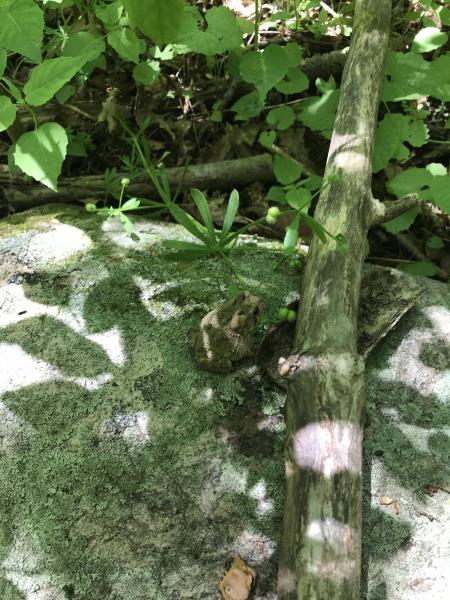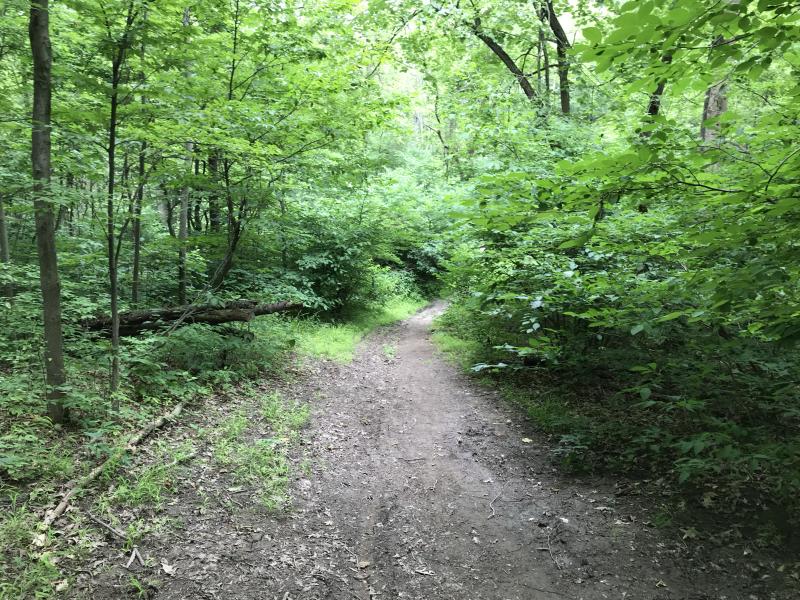Louth Conservation Area is a 36-hectare protected area located in Lincoln County at the intersection of the Sixteen Mile Creek and the Niagara Escarpment. The flow of Sixteen Mile Creek and its tributary down the escarpment forms two waterfalls that make up Louth Falls; the upper falls is 3.66 meters tall, while the lower falls is 7.92 meters tall. Louth is managed by the Niagara Peninsula Conservation Authority as a day use area. The Conservation Area has established trails that go through rich deciduous forests, provides access to the two waterfalls, and connects to the Bruce Trail.
Located in southern Ontario’s Carolinian Forest zone, Louth is composed of hardwood forests. Sugar maples, the most important component of these forests, grow alongside ironwood, red oak, basswood, and black cherries. Common herbaceous plants and wildflowers that grow in the forest understory include gooseberries, raspberries and dewberries, Jack-in-the-pulpit, trout lily, running strawberry bush, Canada mayflower, false Solomon’s seal, and zigzag and bluestem goldenrods. Forests located on top of the escarpment are drier and provide habitat for moisture intolerant species such as burr-oak, shagbark hickory, maple-leaved viburnum, round-leaf dogwood, wild columbines, toothworts, early meadow rue, bellwort, and trilliums. Forests growing on the bottom of the escarpment experience more moist conditions, and favor moisture tolerant species such as bitternut hickory, beech, basswood, sassafras, black locust, jewelweed, lady’s thumb/smartweed, wild geraniums, ferns, and ghost pipe.
Archaeologists have found documentation in the material records and on the landscape of Indigenous peoples living in and traversing Lincoln County for 11,000 years. Archaeological findings in Lincoln County have documented numerous camp sites, findspots and tool scatters dated to the Paleo-indian (10,000 to 8000 BCE) and Archaic (8000 BCE to 500 CE) periods. Indigenous settlements and hunting/harvesting clustered near streams and waterbodies, particularly the Twenty, Sixteen, Fifteen, and Twelve Mile Creeks. These creeks connected land on the top of the Niagara escarpment to Lake Ontario and were important fishing spots.
Prior to the arrival of Europeans, the Niagara peninsula was home to the Attawandaron or Neutral Nation. The Attawandaron lived in large villages composed of longhouses and practiced a combined agricultural, hunting, and fishing food system. By the late 1600s (the Woodland Period), the Attawandaron had built a string of villages on the Niagara peninsula, running east to west, that were located along the Niagara escarpment and major river systems. Jordan Station, located on the Twenty Mile Creek, is the site of an Attawandaron village dating to the 1600s. This village lay on the route of the Iroquois trail, whose route is followed by modern day King Street in the city of Hamilton. In 1615, the Neutral Nation built a 10-acre village in nearby St. Catherines, at a high point called Barbican Heights. The Barbican Heights village (also called Thorold Village), was palisaded and composed of more than 25 longhouses that supported over 1500 people. It was also located close to the Mohawk trail, which was an Indigenous trail that ran along the top of the Niagara escarpment. Because of the village’s size and strategic location, from 1615 to 1630, Barbican Heights was the most important village on the Niagara peninsula, and served as the capital of the Attawandaron Nation within the Niagara region. During this time, the Neutral Confederacy was more populous than Hurons and Haudenosaunee combined; archaeologists estimate the Niagara Peninsula population of Attawandaron at 40,000 people. However, beginning in the 1630s, the Attawandaron suffered severely from smallpox, cholera, and then famine. After 1630, the residents of the Barbican Heights village moved east, first to an area on the outskirts of modern Niagara Falls, called the Saint David’s site, and in 1645, onto Grand Island. Beginning in the 1640s, the Neutral Nation experienced waves of conflict with the Mascouten/ Fire Nation and the Haudenosaunee, as well as conversion of some to Catholicism by Jesuits. They were allies with the Erie, Tionnontates (Petun), and Susquehannock Nations. Some believe that Jikonhsase (alternate spelling Jikonsase, or Tsikonsase), the “Mother of All Nations,” peace queen, and first Clan Mother who co-founded the Haudenosaunee Confederacy with Hiawatha, was Attawandaron/ Neutral, and lived near Niagara (others place her lifetime much earlier, between 1100 - 1400). You can learn more about Jikonhsase by listening to and reading about the Great Law of Peace, the oral history of how the Haudenosaunee came to be a confederacy. Between the 1660s and 1690s, the Attawandaron nation as a political unit dissolved, and Attawandaron people dispersed due to the cumulative effects of disease, famine, and military conflict from the Niagara peninsula, and integrated with the Tionnonates/Petun/Tobacco, Erie, and Huron nations as Wyandots (Wyandottes) to the North/east, Algonquians to the West, or were adopted by their Seneca, Onondaga, and Mohawk captors.
Jackes, Mary. 2008. “The mid seventeenth century collapse of Iroquoian Ontario: examining the last burial place of the Neutral Nation.” found online at: chrome-extension://efaidnbmnnnibpcajpcglclefindmkaj/http://www.arts.uwaterloo.ca/~mkjackes/Valbonne.pdf
Johnson, Lorraine. 2007. The Natural Treasures of Carolinian Canada: Discovering the Rich Natural Diversity of Ontario’s Southwestern Heartland. Carolinian Canada Coalition.
Kelly, Peter E. and Larson, Doug. 2007. The Last Stand: A Journey Through the Ancient Cliff-face Forest of the Niagara Escarpment. Natural Heritage Books.
Niagara Parks Conservation Authority home page for Louth: Louth | Niagara Peninsula Conservation Authority (npca.ca)
| English | Latin | Kanienʼkéha | Anishinaabemowin |
|---|---|---|---|
| Bitternut Hickory | Carya cordiformis | o’nón:na, ontsí:kahwe, yohso'kwatskà:rat | mitigwaabaak (-ook, plural) |
| Shagbark Hickory | Carya ovata | onennóhkara’ | bagaan mitigwaabaak |
| Wild Strawberry | Fragaria virginiana Duchesne | ken’niiohontesha, niyohentéhsha’, niyohontéhsa, ken’niyohontésha | odeimin (-an, plural) |
| Green Ash | Fraxinus pennsylvanica | kaneróhon | emikwaansaak, aagimaak, bwoyaak |
| Sugar Maple | Acer saccharum | wáhta’, ohwáhta | ininaatik, ininaatig (-oog, plural) |
| Jack-in-the-pulpit | Arisaema triphyllum | tyehnónhserote, kyehnónserote, kárhon, tsyorákares, tsorákares, kahnéhserote, okwá:rot nikarhonksherá:'a | zhaashaagomin |
| Musclewood | Carpinus caroliniana | yotenakaratí:wen | Ska’ agon-mins, Shka agonmins |
| Bitternut Hickory | Carya cordiformis | o’nón:na, ontsí:kahwe, yohso'kwatskà:rat | mitigwaabaak (-ook, plural) |
| Shagbark Hickory | Carya ovata | onennóhkara’ | bagaan mitigwaabaak |
| Alternate-leaf Dogwood | Cornus alternifolia | teyotsí:tsayen | moozwemizh, moozomizh, niibiishan miskwaabiimizhiig |
| Gray Dogwood | Cornus racemosa | tsítyete | mazh’omizh |
| Round-leaf Dogwood | Cornus rugosa | (check this) | mazh’omizh |
| Trout Lily | Erythronium americanum | skatsihstóhkonte | namegbagoniin |
| Running Strawberry-bush | Euonymus obovatus | (check this) | (check this) |
| American Beech | Fagus grandifolia | yotyentatí:wen | gawe’mic, sewe-miins |
| Wild Strawberry | Fragaria virginiana Duchesne | ken’niiohontesha, niyohentéhsha’, niyohontéhsa, ken’niyohontésha | odeimin (-an, plural) |
| Green Ash | Fraxinus pennsylvanica | kaneróhon | emikwaansaak, aagimaak, bwoyaak |
| Wild Geranium | Geranium maculatum | tsistáhkwat | bezhigoojiibik |
| Sharp-lobed Hepatica | Hepatica acutiloba | kontirontá:non, karón:tanonhne | gabisan’ikeag, a'nima'sid |
| Spotted Jewelweed | Impatiens capensis | ietsi'erorókhstha, yetsi'erorókhstha | gzhiibosegaateaa, makikiibag, wesa’wasga’skonek, ozaawashkojiibik |
| False Solomon’s Seal | Maianthemum racemosum | kítkit o'éta | agongseminan, agongosimizh, agong’osiminan |
| Ironwood | Ostrya virginiana | tysoráhsa | maananohns, maananoons (-ak, plural) |
| Common Yellow Woodsorrel | Oxalis stricta | teyoratu teyorá:ton | ziiwanabagashk |
| Virginia Creeper | Parthenocissus quinquefolia | kontiráthens | mnidoo- biimaakwad bebaamooded |
| Smartweed | Persicaria virginiana | aweryahsarónyon, tyononhkwà:tsheros | ojig'imin |
| Black Cherry | Prunus serotina | é:ri, e:ri’kó:wa, tyotyò:ren | ookweminagaawanzh, ookweminan, ikwe'mic |
| Chokecherry | Prunus virginiana | tyakonya’tawén:’eks, teyakonya’tawén:’eks | asasaweminagaawanzh, asasaweminan, baakinminaan, asasaweminogaawangh |
| Red Oak | Quercus rubra | karíhton | miskode-miizhmizh, mitig mewish (-iik plural) |
| Swamp Gooseberry | Ribes hirtellum | tyorenatsí:yo, ohrá:ton, anáduma:o:náhi | zhaabo-miinashkoon, zhaaboomin (-aak, plural), me’skwacabo’minak, kaawe-saba |
| Common Dewberry | Rubus flagellaris | sá:yase | odatagaagominag |
| Red Raspberry | Rubus idaeus | skanekwen’terá:yen, skanekwen’terá:ne, skanekwenhtará:nenh | miskomin (-ak, plural) |
| Sassafras | Sassafras albidum | wenhnákeras | menaagwaakmizh, menagwake miins |
| Canada Goldenrod | Solidago canadensis | otsí:nekwar niyotsi’tsyò:ten | ajidamoowaanow, waabanoominens/waabanoominensag, giizisso mashkiaki |
| Zig-zag Goldenrod | Solidago flexicaulis | otsí:nekwar niyotsi’tsyò:ten | ajidamoowaanow, waabanoominens/waabanoominensag, giizisso mashkiaki |
| Dandelion | Taraxacum officinale | tekaronhyaká:nere | mindemoyanag, doodooshaaboojiibik, mindimooyenh, wezaawaaskwaneg |
| Early Meadow Rue | Thalictrum dioicum | otsi’tsyakérha | (check this) |
| Basswood | Tilia americana | ohóhsera | wiigobiish, wiigob, wiigobiig (plural) |
| Poison Ivy | Toxicodendron radicans | yakohón:taras, yakohontaráhstha, wate’nenharì:sere, yakohén:tara’s | nimkiibak |
| White Trillium | Trillium grandiflorum | tsyonatsyakén:ra niyotsi’tsyò:ten, tsyoná:tsik, áhsen niioneráhtonte | ininiiwindibiigegan, baashkindjibgwaan, baushkindjibgwaun, ini'niwin'digige'gun |
| Maple-leaf Viburnum | Viburnum acerifolium | karhata’kéha | miinan |
| Wild Grape | Vitis riparia | o’nénhare | zhoominan, jo’minaga’wanj |
| Cutleaf Toothwort | Cardamine concatenata | à:tsya | waasganjiibik |
| Lamb’s Quarters | Chenopodium album | skanatanòn:wes | nikakzit |
| Burr Oak | Quercus macrocarpa | otokénha | mitigo'mic, bgaak-mizh |
| Le Conte’s Violet | Viola affinis | tekonteniarotáhrhoks, tewatenyarotárhos, tekonnyarotárhoks | We-waawiyeyaa-bagak |

